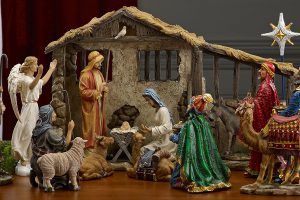
In the ancient Northern capital city of Ethiopia Aksum, there lived one of the greatest Ethiopian composers, Saint Yared. Ethiopia’s genealogy of music from classical Zema to chant compositions could be traced back to the great Ethiopian composer, chorographers and poet Saint Yared. Zema or melody particularly the Ethiopian Orthodox Church’s chants that has been used continuously for the last 1500 years are attributed to St. Yared. His work expressed a form of musical syncretism and his innovations were developed through a combination of formal study and experiences (interactions) he had in and with nature.
Although not well known outside of Ethiopia, Yared is a major innovator in the development of medieval music. According to historical books, Yared was born in Aksum city on 25 April 505 A.D. to his father Adam and his mother Tauklia. When he became six his parents made him to go through tutorship in Aksum. His teacher was Aleka Yishaq. Under this teacher, Yared attended the priest school rote study of the alphabet.
Soon, he began to study the Psalms. However, he faced difficulty to take lessons and was sent back to his parents by his teacher. His father passed away in the meantime. His mother, Tauklia, placed him in the hands of her brother, Abba Gedeon, who was the parish priest and a teacher of the Old and New Testaments in the courtyard of the church of St. Mary. He was known for translating the Holy Scriptures into Geez from Hebrew and Greek.
However unlike fellow students Yared failed to imbibe the psalms and to keep paces with the course. This upset and disappointed Abba Gedeon. Yared became bitter about his failure as a student and decided to go elsewhere and start life anew. He therefore fled from the school. While journeying to his uncle’s birth place, Medebai welel, he was caught by a heavy downpour and was obliged to take shelter in the shade of a tree near a spring called Maikerah, some four kilometers outside the city of Aksum.
While sheltering under the shade of a tree, pondering and feeling remorse about his failure, he witnessed an event that was to change his whole life. His attention was caught by a caterpillar struggling time and again despite repeated failures, to climb up the trunk of a tree to eat of the leaves. Six times the caterpillar failed but on the seventh trial it struggled with all its might and was able to reach at its destination.
Watching the perseverance of the caterpillar, Yared wept and self-criticized, himself comparing his weakness with the strength of the little creature. After seeing the stamina of the tiny creature, he decided to return and take up his studies again. He reasoned that a man is a superior creature compared to a caterpillar. He reasoned, with repeated effort, as the caterpillar had reached its goal and eaten of the leaves of the tree. He too should bear punitive measures such as a walloping and hard work like studying diligently to emerge successful.
Having reached on such a decision, he returned to his spiritual teacher, Abba Gedeon and beseeched his teacher to accept him back to continue his studies. His probing eyes of nature inspired him to maintain focus on his studies of the Holy Scriptures. During his return to the seminary, Yared came into his full intellectual potential and composed a system of musical notation. He further developed a passion for music and authored several religious hymns and songs.
Yared’s musical notation was developed centuries before the European seven-letter based system. Each composition is based on a combination of local traditions and the concept of the Holy Trinity. He divided his hymns into four segments representing the four seasons of the year: winter, summer, spring, and autumn, each with their own melodies. Yared compiled these works into a pamphlet he called The Book of Digua or chants of sorrow and tearful songs in the language of Ge’ez.
He organized his compositions into three modes reflecting the Holy Trinity. In his composition “Deggua Yared” he created ten musical tones with notation. Yizet, Deret, Rikrik, Difat, Cheret, Qenat, Hidet, Qurt, Dirs, and Anbir. His composition consisted of dashes, curves, and dots each having a particular meaning. The three musical terms such as ge’ez ,Izil and Araray, which are the foundation of the Ethiopian music , were coined by St. Yared .They were meant to represent the three main Zema or melody compositions.
He came up with the composition after hearing how the three birds sat on a tree were singing and chanting. According to the book of May II Sinksar or Lives of the Saints, which narrates the full story how Yared created the chant and notation system after inspired and guided by the Holy Spirit, there was no set of rules for the liturgical chant at that time. In the book, it is written three angels were sent from paradise in the form of three birds to teach Yared heavenly songs in his own language.
The birds circling in the air in front of Yared sang sweet and captivating new songs. Yared had no option than to stand still mesmerized by the mellifluous music. Saint yared’s chants are characterized as subtle, spiritually uplifting and euphoric. Through elaboration and visual representation of chants, the introduction of additional musical instruments, movements and performances by Ethiopian priests have further enriched and secured the continuity and dynamism of the trading to the present. It is a classical tradition both musically and culturally.
Furthermore, the music has become the central defining ritualistic feature of all the major fats and feasts appropriately expressing and performing joys and sorrows of the faithful. Saint Yared died at the age of 66 .Yet, his works still resonate in Ethiopian music. The name Yared conjures up on Ethiopians’ mind as the inventor of melody. By composing chants for all natural and spiritual occasions St.Yared has also laid down the foundation for common purpose and plurality among various ethnic and linguistic and regional groupings of the Ethiopian People.
His music also reflects the national sentiment and Ideals of Ethiopian people. It is believed that some of the songs, especially those from the Old Testament, were used for singing and praying by many devoted Ethiopian churchmen before Christ. Therefore it showcases the existence of the art of music in Ethiopia during Old Testament times. Saint Yared of Aksum must be credited for not only for most of the music of the Ethiopian Church but also of the creative works of the African Empire.
In cognizance of this, recently, The City Administration of Aksum has announced its plan to commemorate the great composer with a statue at the heart of Aksum, his home town. According to Elias Kahsay Axum City Vice Mayor, preparation are finalized to lay down the cornerstone of his statue. for annual celebration of the saint where his birthday marked on April 25 and his annual ceremony approaching in next week May 19 Ethiopian calendar.
“The plan to commence the statue has been long projected for the remembrance of saint Yared to let people know who he was and what he has contributed for his country. It as well help the current generation to know their history and follow in his footsteps of creativity,” said Elias According to him, beyond serving as an additional attraction site next to Axum obelisk, the stature would add some asset for Aksum’s image.
“Even though we are looking for sponsors, the whole budget would be covered by the city administration.” It was noted that the construction of the statue is expected to be finalized by the next annual Aksum Zion pilgrimage carnival November 28th , where thousands of the faithful gather from across the country at Zion Mariam, Aksum.
The Ethiopian Herald Sunday Edition, May19/ 2019
BY FASICA BERHANE




